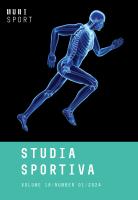Handgrip Strength Asymmetry in Elite Young Czech Male Tennis Players: Implications for Injury Prevention
Handgrip Strength Asymmetry in Elite Young Czech Male Tennis Players: Implications for Injury Prevention
Author(s): Tomáš Válek, Adrian Agricola, Petr Konečný, Robert Vysoký, Jiří ZhánělSubject(s): Psychology, Educational Psychology, Health and medicine and law, Sports Studies
Published by: Masarykova univerzita nakladatelství
Keywords: bilateral asymmetry; dominance; dynamometer; handedness; laterality
Summary/Abstract: The term laterality refers to the preference or dominance of the lateral asymmetry of the human body. The prevalence of left-handedness is reported to be 10–13%, but in some interactive sports (e.g., fencing, racquet sports), the proportion of left-handers is higher. The left-handedness is considered an advantage in tennis; however, the one-sided load can cause muscular dysbalances leading to injuries. The research aim was to assess bilateral differences in handgrip strength youth male tennis players under-14 as to injury prevention (n = 232). In the study 12.5% were left-handed players. Handgrip strength was tested using a digital hand dynamometer (TKK 5401). A significant difference in grip strength in favor of the dominant hand was found between all players and right-handed players, only a non-significant difference was found between left-handed players. Regarding injury prevention, a difference between dominant hand and non-dominant hand force of >15% was found in 5.6% of players (high risk of injury) and >20% in 1.3% of players (very high risk). This predicts an increased risk of injury, so it is desirable to pay attention to both sides of the training load and to include compensatory or strengthening exercises.
Journal: Studia sportiva
- Issue Year: 18/2024
- Issue No: 1
- Page Range: 223-233
- Page Count: 10
- Language: English

